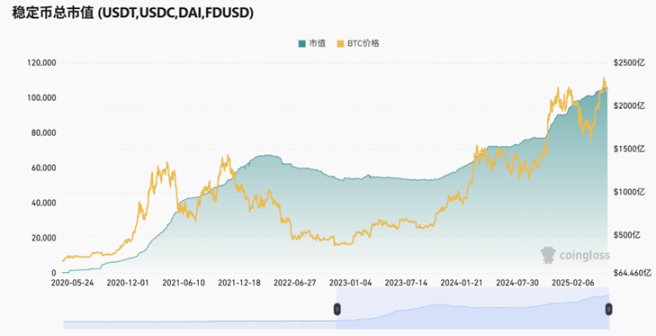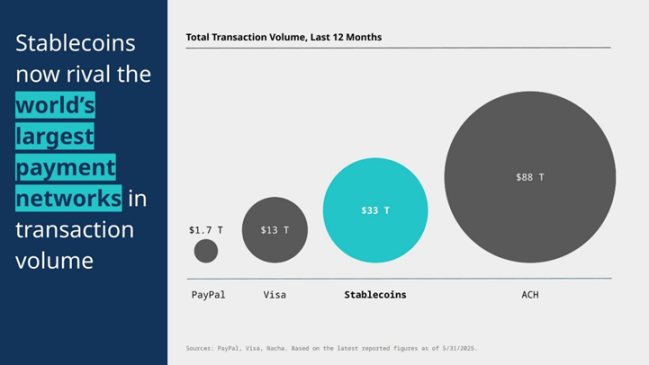Why is Circle's IPO another landmark event in the crypto industry?
Last Thursday night, Circle, the issuer of USDC, the world's second-largest stablecoin (about 25% market share), was officially listed on the New York Stock Exchange at an issue price of $31 per share, and Circle triggered circuit breakers several times during the session, closing with a 168.48% increase on the first day of listing at $83.23, with a market capitalization of more than $18.5 billion at the end of the day, and continued to rise nearly 30% the next day.
At present, the total market capitalization of global stablecoins has exceeded $250 billion, of which USDT and USDC together account for 86% of the market share, which is why Circle repeatedly adjusted its opening pricing on the eve of the IPO, because the market was much hotter than expected.
Because of Circle's listing on the New York Stock Exchange, the concept of "stablecoin" has dominated the financial headlines for several days, and to some extent, it has also made more traditional financiers re-realize the value of stablecoins.
In addition, almost on the same day, the Hong Kong Special Administrative Region officially issued a document clarifying August 1, 2025 as the implementation date of the "Stablecoin Ordinance", which further boosted the popularity of stablecoins in the financial market.
Let's not talk too much about the value of stablecoins here, after experiencing the explosive growth in recent years, if we still deny the meaning of their existence, we probably need to rethink and adjust our cognition just like saying "BTC is useless" now.

Rewind to almost the same time period 4 years ago, that is, in the last bull market cycle, Coinbase, the largest crypto exchange in the United States, successfully landed on the NASDAQ, and its stock price soared to $429 on the first day of listing, with a market value of more than $112 billion, bringing hundreds of times returns to many early-stage investment institutions.
But then it ushered in a period of more than 2 years of adjustment, and the performance in the months after the listing was also criticized, and even called it a "junk company", but it is precisely because of the successful listing of Coinbase that the traditional financial market has seen another emerging financial market that is rising, and there is now a BTC ETF and various reserve assets.
Similarly, for the listing of Circle, its significance is that it has made stablecoins, which were originally only recognized by a certain number of people, truly appear on the "Hall of Elegance", and also won the favor of some old money. After all, it is difficult to enter the mainstream world if you only stay in the field of vision of a small group of people, especially through listing to show your financial ability and corporate transparency, which is crucial for the development of stablecoins.
As Jeremy Allaire, co-founder of Circle, said in an interview with Bloomberg, "The IPO will bring more trust, compliance, and transparency to Circle's regulated stablecoin network, as well as help it build partnerships with other financial institutions."
In 2008, Satoshi Nakamoto proposed the "trustless currency" form and created BTC, the ideal at that time was to use a new form of money like BTC to fight against financial institutions that issue money abusively, but now BTC is no longer effective as a means of payment due to various restrictions, which is why stablecoins can develop rapidly.
In a sense, stablecoins replace part of Satoshi Nakamoto's ideals, of course, only "formally", after all, stablecoins have returned to institutional logic, only borrowing their technical form, but based on this, we cannot deny their value.
In its latest report, a16z Crypto noted that stablecoin trading volume has reached $33 trillion over the past 12 months, continuing to hit record highs, nearly 20 times the volume of PayPal transactions and nearly 3 times the volume of Visa transactions.

Some people may think that the current market size of stablecoins is not small, but compared with the traditional payment market size of ten trillion US dollars, it seems a bit "naïve", but if it is said that in the next 3-5 years, stablecoins are expected to become a single trillion-dollar market, perhaps it has just passed the initial stage.
Therefore, the listing of Circle is more like a small carnival to bring "righteousness" to the stablecoin, and the big drama after the carnival has just begun. As the most mature application in the crypto industry other than trading, stablecoins may be the real stepping stone for Web3/Crypto applications to enter thousands of households, rather than the frenzy of NFTs in the early years.
For investors and entrepreneurs, there are also a lot of opportunities during this period, after all, making money with money is always a good business, but if you can't be a creator of money, at least you can be a service provider in this field, everything has just begun, and risks and opportunities coexist.
So, what will be the Circle market cap in 4 years?
